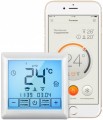Connection
How to connect the controller to the controlled device.
—
Wired. Connecting with wires is the most common option. It is due to its main advantages — simplicity, reliability and low cost. On the other hand, the wiring itself can be quite troublesome and time-consuming.
—
Wireless. Wireless connection — usually by radio channel. To do this, the kit usually provides an external transceiver connected to the controlled device. The main advantage of wireless models is obvious — they are much easier to install because no need to run extra wires. On the other hand, such a technique is much more expensive than wired, and communication has a limited range, which is further reduced if there are obstacles (such as thick walls) in the signal path.
—
DIN rail. The phrase "on a DIN rail" traditionally refers to the method of installing the device (see "Mounting"); the connection is usually carried out by wire. However, this option is taken out separately for the reason that DIN devices are standardly mounted in a distribution cabinet — unlike conventional wired
thermostats, installed directly in the room. However, sometimes it is an advantage: the distribution cabinet can be locked with a key, restricting unauthorized access to the thermostat. Models with such a connection usually refer to professional equipment used in industrial
...facilities, warehouses, etc.Max. load
The maximum load in terms of current power that the thermostat can withstand. In other words, the maximum electrical power that it can pass through itself without failures and damage.
The choice for this parameter directly depends on the power consumed by the boiler or heater connected through the thermostat; load limitation is of particular importance when working with electric boilers, the energy consumption of which is measured in kilowatts. When connected directly, the power of the heater should not exceed the maximum load of the thermostat, otherwise the latter will simply fail. However, when using additional protective devices (contactors), many models allow connection to a more powerful load than originally allowed.
Temp adjustment range
It is the range in which the air temperature can be set on the regulator. The choice for this indicator depends on the expected conditions in the room. So, in a residential building, the lower temperature limit at the level of 5–10 °C is quite sufficient; the upper limit is within 30–40 °C (regardless of whether we are talking about air or floor temperature). But in control devices designed for industrial use, this range will be much wider — from sub-zero temperatures to the upper limit of 100 – 125 °C.
Sensor cable length
The length of the supplied cable in the wired thermostat sensor (see "Type"). The longer the cable, the further the temperature sensor can be installed from the device. At the same time, the principle “the more the better” is quite relevant: excess wire usually does not create any special problems, but if the length is insufficient, you will have to lengthen the cable, or even purchase another sensor.
Note that in modern models, the cable length usually does not exceed 4 m — this is usually enough when installing a thermostat in the same room but with the removal of the device outside the room, difficulties may already arise.
Programmable cycles per day
The largest number of individual cycles that the thermostat timer can set in one day.
The cycle is the period during which the thermostat operates on one set of settings. For example, if there are 2 cycles, you can provide turning off the heating while you are at work and turn it on shortly before returning home. However, most thermostats provide a noticeably larger number of cycles — up to 24.
Note that in weekly timers (see "Timer type") this parameter may differ depending on the day of the week. For example, weekdays usually have more extensive settings than weekends.

